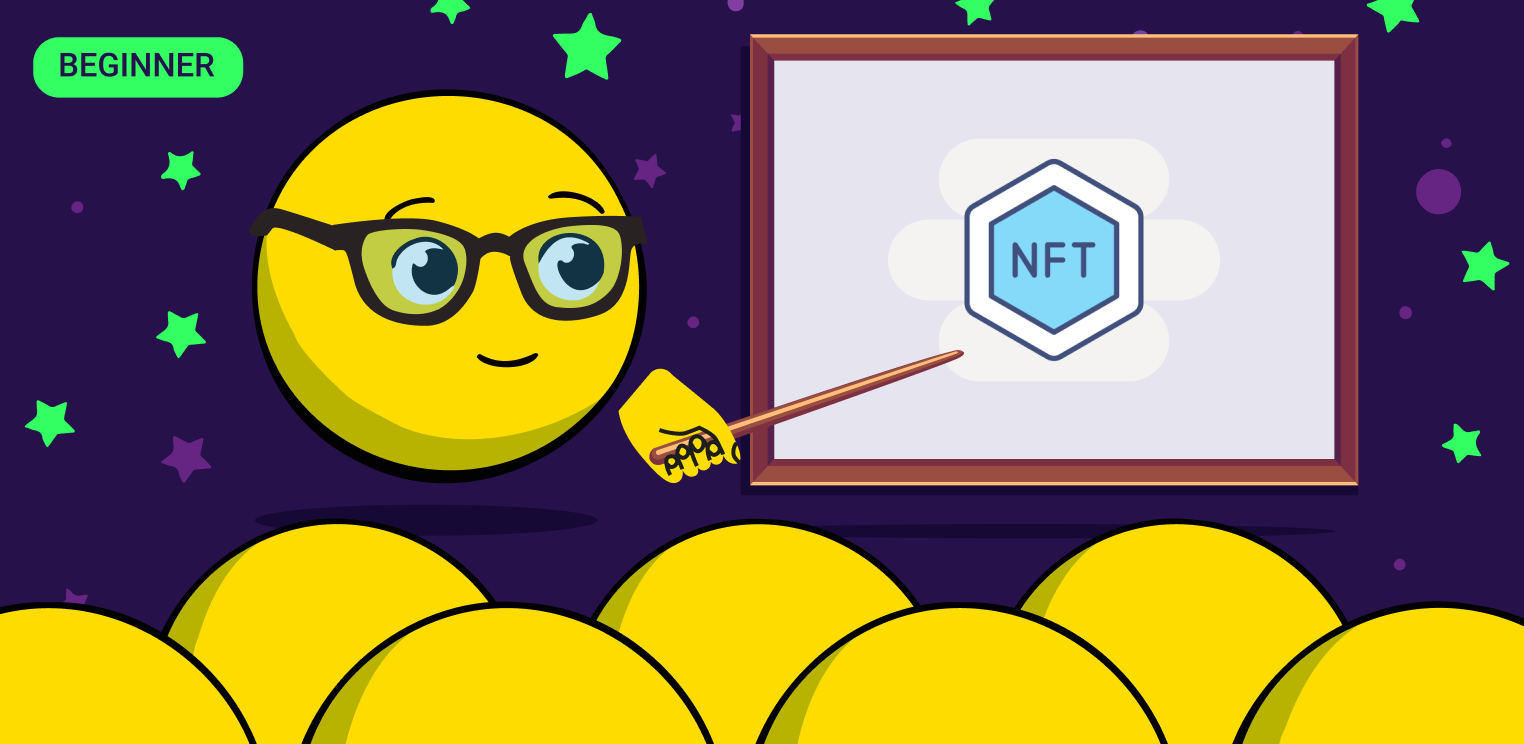
NFT is an entry in the blockchain registry that represents a real object. Thanks to NFT, you can digitize any object — such as a picture, a video, and so on. This is a digital certificate that confirms the possession of a certain asset.
The technology works like this: all tokens are different from each other, and none of them can be forged, divided, or quietly replaced with another. This is necessary so that their owners can consolidate their rights to any unique object, from an object in their favorite computer game to a masterpiece that exists in a single copy.
Everyone can issue their NFT token; in the code, you can find all the information about the product, from the name of the owner to the history of transactions with him. And this information will always be available and reliable, which means that there will be no doubt about the authenticity of the art object.
Each token is unique; it cannot be replaced by another. For example, you can borrow $100 from a friend and give it to another bill because this is an interchangeable resource. Same with cryptocurrencies. But if you take a photo from a friend autographed by your favorite actor and give a similar photo with another person's signature, the value of these things will be different. Such a photo is comparable to NFT.
The History of The NFT Technology
The technology appeared in 2017 and took as its basis the smart contracts of the Ethereum blockchain. Smart contracts specify agreement codes and how to use an object. In the real world, the contract is signed; in the digital world, such a function is performed by a token.
Initially, NFT technology supported blockchain art: it protected the copyright of unique content. Determining the authorship of a picture in the digital world is difficult. A JPG original image is the same as a copy. When uniqueness is lost through copying, the author remains unknown if users do not specify his name under each publication. When an image receives an NFT token, the copy history is preserved, and each user exactly knows the author and owner.
The first transition of a real work of art to digital was a performance. Injective Protocol bought Banksy's 2007 Morons (White) stencil for $95 thousand. The first NFT was burned, leaving only a virtual version in the form of an NFT token.
Now, tokens can represent not only NFT paintings but also the author's images, music, photos, videos, and game items. Even real-world objects: cars, and real estate can be tokenized. Perhaps in the future you will not have to get paper documents because NFT will even replace IDs such as passports.
How to Buy NFT
You must first select one of the sites. NFT platforms trade in digital objects in cryptocurrency, sometimes in dollars.
Examples of these NFT projects:
- Juggerworld;
- Treasureland;
- Blockparty;
- Nfty Gateway;
- Rarible;
- OpenSea;
- NFT STARS;
- NFT-X.
The buyer receives a digital certificate with unique blockchain data and stores the object on any device: in smartphones, in the memory of a computer, or on a flash drive. The object itself remains in the IPFS (Inter-Planetary File System) for indefinite storage. Other users will be able to download and view the object, but only one user has a private key (certificate). The owner has the right to issue public keys to other users when copying an object to authenticate it.
You can mint Invaders Club NFT for free right on SwapSpace and enjoy perks like USDT payouts and cashback benefits. Join the exclusive community and discover a new dimension of rewards and possibilities here.
The Use of NFTs
Earnings of content authors
Usually, authors promote the platforms where they publish their content. In exchange, they receive advertising and virality, but not money directly. With NFT, royalties from the use of its content are available to the author.
Copyright protection
Before NFT, you had to sign or watermark objects to keep the author's name. The method worked poorly, and the author's name was often lost. The blockchain records the creator of the object, the current owner, and the resale history.
Replacement of digital documents and tickets
With NFT, ownership of real estate or a car is confirmed by a token instead of a paper document. The technology is also used to sell tickets for events. The difference with regular electronic tickets and documents is in the degree of protection: NFT cannot be forged or stolen.
Content interactivity
NFT adds interactivity to the media content and includes the user in its creation.
Example. The creators of the comedy series The Gimmicks handed out free tokens with which users voted every week for plot development options. Also, participants receive a unique NFT character from the world of the series and can even become assistants in the production team.
Investments
Buying digital objects is a profitable investment. NFT is often expensive; digital objects are resold for impressive amounts, but it is impossible to say for sure which NFT will soar in price. Not all NFTs are valuable; it depends on the author and their characteristics. So, Elon Musk put up for sale his tweet in the form of NFT. The price of the item at the auction exceeded a million dollars.
Another case for NFT is that it can be used as proof of identity or the authenticity of documents or items. Zachary Ignaffo, an information privacy specialist, believes that in the future, users will have access to the Internet using a special online license from NFT. That is, to be online, you must identify yourself. So you can use a fully secure network with a minimum of fraud and control who has access to information about you.
Different Types of Tokens
Interchangeable token
If you take a banknote with a face value of a hundred US dollars and then give the same, then there will be no difference. Although banknotes are different (each with its own number), they are equivalent and replace each other. Cryptocurrency also works in the digital world. Any Bitcoin is the same because everyone has an interchangeable token.
Partially interchangeable token
If you buy a ticket for an electric train, then it will not be unique; other passengers will have the same ticket that you can exchange. But if you take a train ticket where a specific seat is indicated, then there can be no such thing. In the digital world, this ticket would combine the characteristics of an interchangeable token (passengers can exchange tickets for one train and still get to their destination) and a non-interchangeable token, because a specific place is indicated that is unique on the train. Therefore, a train ticket with a specific location would receive a partially interchangeable token.
Non-fungible token (NFT)
If you buy a painting that is sold in a single copy, you can no longer replace it with a copy; this is another work of art with its own characteristics. When such a product exists only in the digital world, the object is assigned an unimaginable token (NFT).
An example of a very popular NFT project that has conquered the world is the game CryptoKitties. Digital pets with a unique token can be bought here. NFT crypto cats are bred, crossed, and result in a new kitten. The blockchain code here works as a genetic code: each new kitty will be unique.
Summary
NFT (non-fungible token) is a blockchain-based technology that confirms the uniqueness of a digital object, protects copyright, and preserves the history of changes and resale.
It is impossible to support NFT, but simple to create. A digital object is downloaded to one of the NFT sites, and a price is indicated in cryptocurrency (sometimes in dollars).
With technology, they sell works of art, pictures, music, and even game objects. NFT even replaces paper documents when buying real estate or a car.
The technology gives earnings to content creators who receive royalties. Also, NFT is an alternative to classic investments. Digital objects are growing in price and are often sold at auction for thousands or even millions of dollars.

